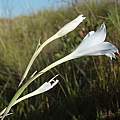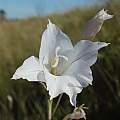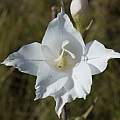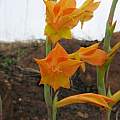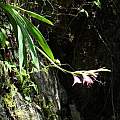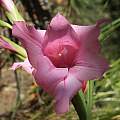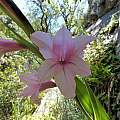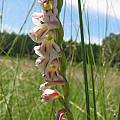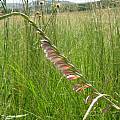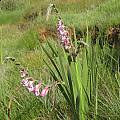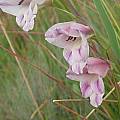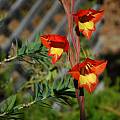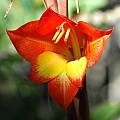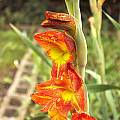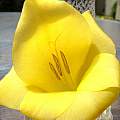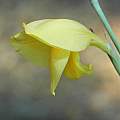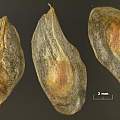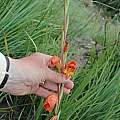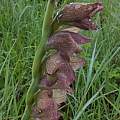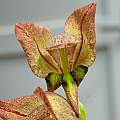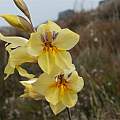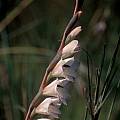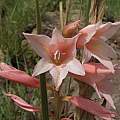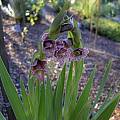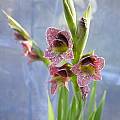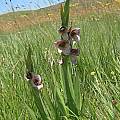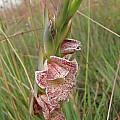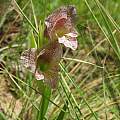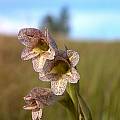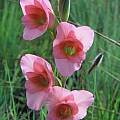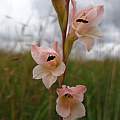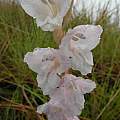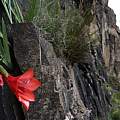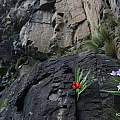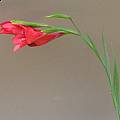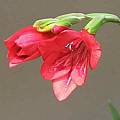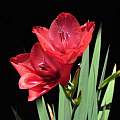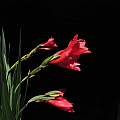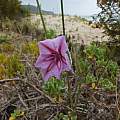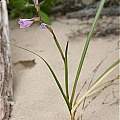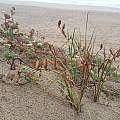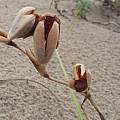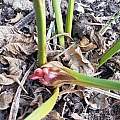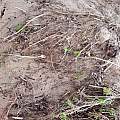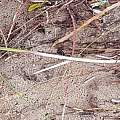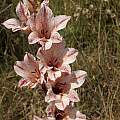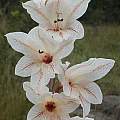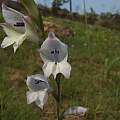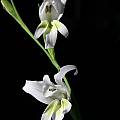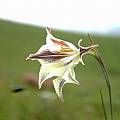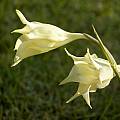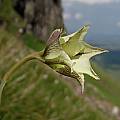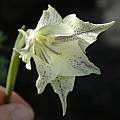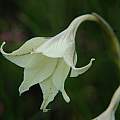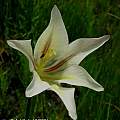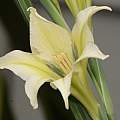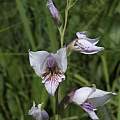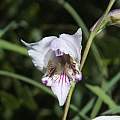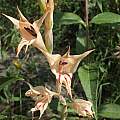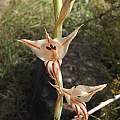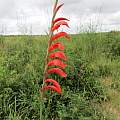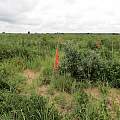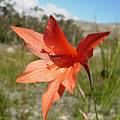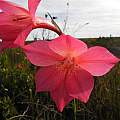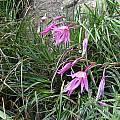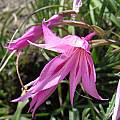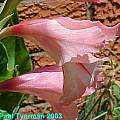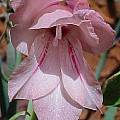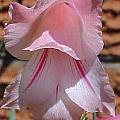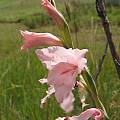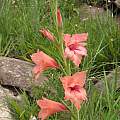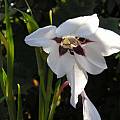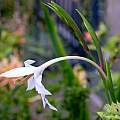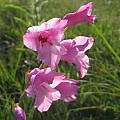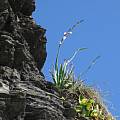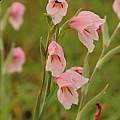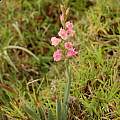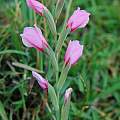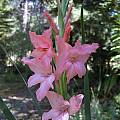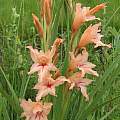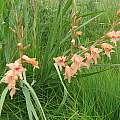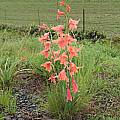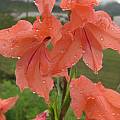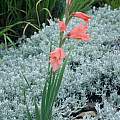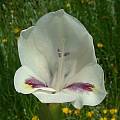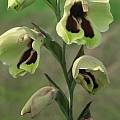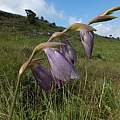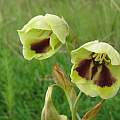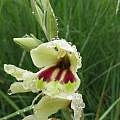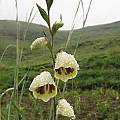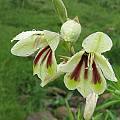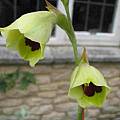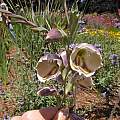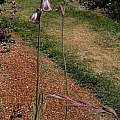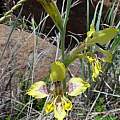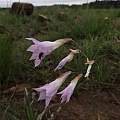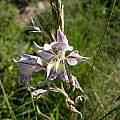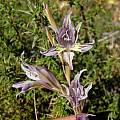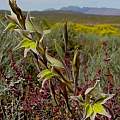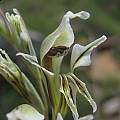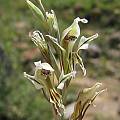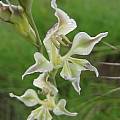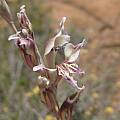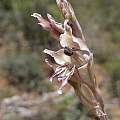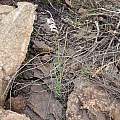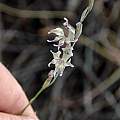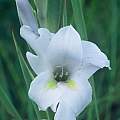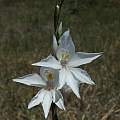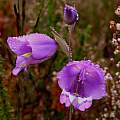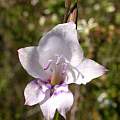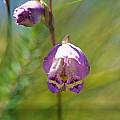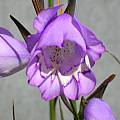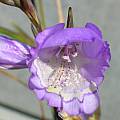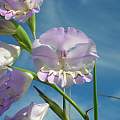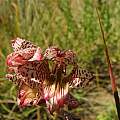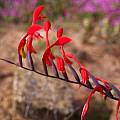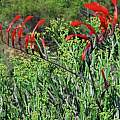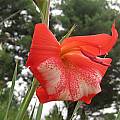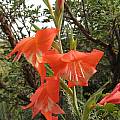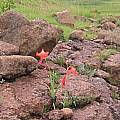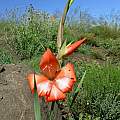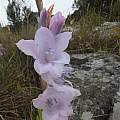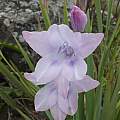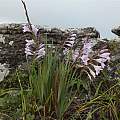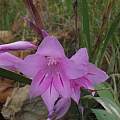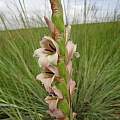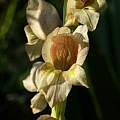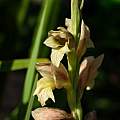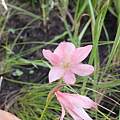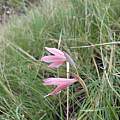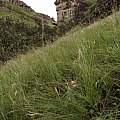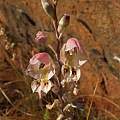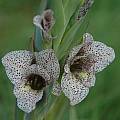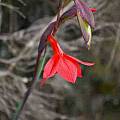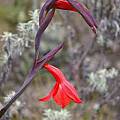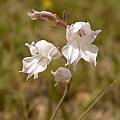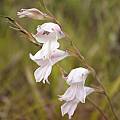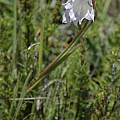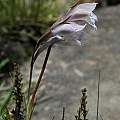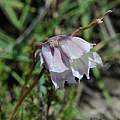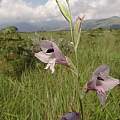Summer rain Gladiolus are mostly from the eastern part of South Africa. They generally like their summers wet and their winters dry, but just exactly how wet and how dry may vary widely depending on on the exact location of origin. Among the summer rain species are some of the most frost hardy of the African species, but as most tropical African Gladiolus follow a summer rain pattern as well, some are quite frost tender.
Gladiolus albens Goldblatt & J.C.Manning, syn. Gladiolus maculatus Sweet ssp. eburneus Oberm., is a narrow endemic of the Eastern Cape where it is found on grassy slopes and in fynbos type vegetation on light well drained soils. Although it grows primarily in a summer rainfall zone, the area where it grows does get some winter rainfall and this species flowers in the fall in April and May and has its main growth in winter after flowering. Plants are generally 25 to 50 cm high and the flowering spike has 1 to 3, rarely to 5, flowers. Flowers are white to cream, sometimes with faint speckles or streaks in the throat or all over the tepals, with a long slender perianth tube (35-50 mm) that expands in the upper part and have a dusty sweet scent. Photos taken by Rachel Saunders in the Eastern Cape.
Gladiolus antholyzoides Baker is distributed across the central and eastern high veld of South Africa. Flowers are yellow, sometimes streaked with red or orange and with an orange ring around the throat. This species was once included in Antholyza as Antholyza laxiflora and Antholyza schlechteri, presumably because of its long perianth tube. It has also had other Gladiolus species names.
Gladiolus appendiculatus G.J.Lewis is native to the Northern Provinces, South Africa and Swaziland where it grows in grassland on mountain slopes usually above 1800 m up to 2100 m. Growing from 35 to 60 cm, it has softly leathery 6 to 9 long leaves tapering to a sharp or blunt tip and 6 to 14 white to pink unscented flowers marked mauve or pink in the lower tepals, borne on one side. The tepals are unequal in size with the upper three largest and the dorsal arching over the stamens. Anthers have long tails. Flowering occurs in April and May. Photo from Rachel Saunders.
Gladiolus aurantiacus Klatt is found in the summer rainfall area often growing in high grassland and is centered in KwaZulu-Natal extending into Mpumalanga and Swaziland. Growing from 45 to 75 cm high, it has stem leaves with short blades and foliage leaves with longer blades that are produced on separate shoots near the end of flowering. The unscented flowers are yellow, dotted or streaked with red or orange which gives them the appearance of being orange borne on a 10 to 16 flowered erect spike. Flowers have an elongate flower tube, slender in the lower half. The dorsal tepal is slightly ascending to horizontal and the lower tepals with yellow blotches in the lower half curve sharply downward. Flowers are adapted for pollination by sunbirds. Flowering is unusual as it occurs early, mostly in September and October, before the main rainy season has started. Photo from Rachel Saunders.
Gladiolus cataractarum is a rare endemic of the southern African summer rainfall region. Plants grow on cliffs and steep rocky slopes on quartzite in sheltered, south facing sites. Growing to 70 cm high, this species has eight to nine lanceolate leaves of different sizes and pink unscented flowers with the lower three tepals marked with reddish longitudinal lines. The first photo of the plant in habitat taken by Rod Saunders. Flower photos from Rachel Saunders. They had to walk up a gully to reach it and found it difficult to photograph hanging off the cliff.
Gladiolus crassifolius Baker (syn. G. rachidiflorus, G. thomsonii, G. masukuensis, G. mosambicensis, G. tritoniiformis, G. junodii, G. coranthii, G. gazensis, G. dieterlenii) is a widespread species of eastern southern Africa. It is found also in tropical Africa. Plants in southern Africa usually grow in hilly country in well-drained rocky grassland habitats and bloom late summer. Plants in tropical Africa bloom earlier before the new season’s leaves have developed. Flowers are borne in a 16 to 22 flowered spike and are usually pale to deep pink or light purple. The lower lateral tepals have a dark band of color across the lower half of the limbs. Photos taken by Cameron McMaster at Maclear and Sentinel Peak in the Eastern Cape in 2008.
Gladiolus dalenii Van Geel is a widespread and common species found not only in Southern Africa, but also in other parts of tropical Africa. It has been known by a number of names over the years; there have been 27 synonyms for the tropical Africa and Madagascar forms and 14 more for the southern African forms. The main synonyms for the southern Africa collections have been Gladiolus natalensis and Gladiolus psittacinus. This species blooms at different times of the year depending on the location, but there are probably flowers every month of the year somewhere in its native habitats. Flowers are either red to orange with yellow markings on the lower half of the three lower tepals or yellow to greenish with red to brown streaks on the upper tepals. Although it favors moist habitats and is often found in grassland, it can also be found in dry habitats with only a short wet season. The ones I grew in Northern California lived for a number of years in the garden, dormant during our wet winters, appearing late spring and surviving through the dry summer and blooming in the fall. The flowering stalks were very tall with a number of flowers. Photos 1-2 of those plants were taken by Mary Sue Ittner. Photo 3 by Cameron McMaster shows plants in cultivation. Photos 4-5 by Mary Hunter and Mary Sue Ittner show the first bloom from seed of a yellow form of ssp. dalenii, once known as Gladiolus primulinus blooming in late summer in Northern California. The last photo by David Pilling shows seed.
The first photo below from Cameron McMaster shows flowering plants in habitat in the Eastern Cape. The second is another habitat shot taken near Balloch in the Eastern Cape, January 2010 by Bob Rutemoeller. Photo Nr. 3 from Rachel Saunders shows an unusual color form and was taken in northern KwaZulu-Natal in January 2015. The last photo shows the beautiful detail on likely the same color form, as the seeds were obtained from Silverhill, flowering the second year from seed for Martin Bohnet.
Gladiolus delpierrei Goldblatt grows on marshy sandstone slopes at 1200 m in the Cederberg Mountains. Growing from 40-45 cm high and blooming December to January, it has yellowish cream flowers with yellow and red marking on the lower tepals. Photo taken January 2014 by Rachel Saunders.
Gladiolus densiflorus Baker is a species found in the lowveld and coast of eastern southern Africa. It grows in open grassland, usually on deep soils in high (summer) rainfall areas. It has small, short tubed, cream, greenish, pink, mauve, slate-grey or occasionally orange flowers that are usually minutely speckled with pink to purple spots. Photo taken by Rod Saunders.
Gladiolus dolomiticus Obermeyer is a rare summer rainfall endemic found on dolomite hills, dry woodland, and dolomite slopes at 1700 m in Makapan's Valley in the Northern province. It flowers in March and April at the end of the rainy season. Growing 70 to 100 cm with rigid hairy leaves with thickened margins and primary and secondary veins, it has a spike of 10 to 17 short tubed pale pink flowers. The lower tepals have a blotch in the midline and the throat is pale yellow. Photo from Rachel Saunders.
Gladiolus ecklonii Lehmann (syn. G. marmoratus, G. inclusus) is widespread in the summer rainfall area where it is found in well watered low grassland. It has flowers that are minutely spotted or dotted pink, red or purple on a white background. The lower tepals are yellow to cream. The flowers may be so evenly covered with uniformly pink or dark red spots that they look that color. From a distance the flowers on my plants looks almost brown. The attractive leaves are bright green in a fan with thickened margins. The species is named after C. F. Ecklon, the plant collector who first sent seeds of it to the Hamburg Botanic Garden. The first two photos are of plants blooming September 2004 in California by Mary Sue Ittner.
The first four photos were taken by Cameron McMaster in the Eastern Cape and the last was taken by Rod Saunders.
Gladiolus exiguus G.J.Lewis grows in open grassland in well drained sites at high elevations in the northern Drakensberg escarpment of Mpumalanga, South Africa. Growing from 30 to 40 cm high, it has 7 to 8 leaves with the lower forming a crowded fan and pale creamy to deep pink unscented short tubed flowers. Photo from Rachel Saunders.
Gladiolus ferrugineus Goldblatt & J.C.Manning grows in marshy grassland or well watered stony slopes in the summer rainfall area in eastern Southern Africa from the Northern Province to North Swaziland. Growing from 35-60 cm, it has 6-8 channeled leaves with the largest leaves twisted, and small white to pink short tubed flowers with rust colored bracts. The lower lateral tepals have cream to pale yellow blotches in the midline. There are two distinct forms. The form from the lower escarpment flowers in summer from late November to early February and has broader leaves and shorter tubes and the form from the upper escarpment flowers in autumn (March and April) and has narrower leaves with thickened margins and twisted blades and longer tubes. Photo from Rachel Saunders.
Gladiolus flanaganii Baker grows on the cliffs of the Drakensberg mountains in KwaZulu-Natal which form the border between Lesotho and South Africa. Long ago, plant collectors would risk death to see/collect these plants, thus it has gained the vernacular name "Suicide Lily". In milder climates maritime, it does well in a very well drained mix, full sun, and occasional watering. Water should be given often during hot spells. Keep the bulbs dry during its winter dormancy.
The photos below were taken by Callan Cohen of plants in habitat.
Photographs 1-2 taken by David Victor are of a wild collected material recently given to him by Danish friends. Photo 3-5 were taken by Nhu Nguyen who grows this in his Berkeley garden in a 1 gallon pot.
Gladiolus gueinzii Kunze grows on coastal sand dunes at and above the high tide mark in the southern Cape where it occurs in both the winter and the summer rainfall areas. It produces small cormlets around the base of the buried corm like other species, but also produces a large glossy dark corm that is bouyant in the water and is dispersed to new areas by floating. Growing from 25 to 50 cm high, this species has four to eight mauve flowers with red-purple and white markings on the lower tepals. It flowers in late spring to summer. The first photo was taken by Rachel Saunders. The second photo was taken on the Otter Trail by Andrew Harvie.
Photos from Paul Sieben who comments: "The first photo reflects how close to the sea they grow and flourish. The base of the dune would have been cut by the past equinox spring tides. The second shows how big the pods are and how full they are relative to the flower. All the flowers I have seen have been very similar to the one that Andrew Harvie took (above), they hardly open. The abundance of seed and plants could be due to the closure of our beaches (in 2020) and a lengthy lockdown period here in SA, far less trampling of the dune area as this is at a popular access point".
Photo 3 shows how offset bulbs form around the base of the stem and result in clusters of plants.
In September 2023 "We have had extreme storm surges associated with Spring equinox tides which has stripped the coast of sand exposing the bulbs. This shows the white stem indicating that the bulbs are between 200 and 300 mm below the surface. In my experiences this is very deep for gladioli bulbs, it is possibly to prevent dehydration on the dunes. At least 70 % of the bulbs have been washed away in this one incident".
Gladiolus hollandii L.Bolus grows on lower slopes of mountains and on granite outcrops, often in well drained gritty soil in light to moderate shade in the eastern southern African lowveld (Northern Province, Mozambique, Swaziland). Plants grow from 0.6-1.2 m and have a multi-flowered spike of 18 to 30 and sometimes more pale pink minutely dotted dark pink unscented flowers with a reddish median streak running the length of the tepals. Flowering time is mid February to April. Photos by Rachel Saunders.
Gladiolus inandensis Baker is a species that grows in small clumps to 20 to 45 cm. It is mostly found on sandstone soils in KwaZulu-Natal and the Eastern Cape, but it also has been recorded in Lesotho. Plants are found on rocky grassland and flower early in the summer rainfall region, mostly July to August, extending into September. This species has small white to cream flowers flushed with purple on the outside of the tepals. The dorsal tepal is hooded over the stamens. This species is unusual in that the flowers are usually produced before the new leaves on short stems with the dry dead previous foliage leaves attached to their base. This species is very similar to Gladiolus wilsonii but that species produces a stem after the new leaves are produced and flowers at a different time. Photo from Rachel Saunders.
Gladiolus involutus D.Delaroche is found on clay slopes in renosterveld and grassland in areas with summer and winter rainfall. Flowering from winter into spring, it has white flowers with yellow-green markings on the lower tepals. Photo by Bob Werra.
Gladiolus longicollis Baker is a species found in a wide area of southern Africa, including the southern Cape, the eastern Cape, the Free State and the Northern Province. It has pale yellow to white long tubed flowers that are either uniformly colored or mottled with brown. Flowers are night blooming and sweetly scented of carnation and cloves. There are two subspecies:
Gladiolus longicollis ssp. longicollis has a shorter perianth tube and transparent upper tepals and flowers October to November. It is found from Oudtshoorn in the Western Cape through the Eastern Cape and Free State and into Lesotho and Gauteng where it usually grows on moist, south facing slopes in low grassy fynbos or rocky grassland.
Gladiolus longicollis ssp. platypetalus (Baker) Goldblatt & J.C.Manning has a longer perianth tube and broader petals with the outer whorl tepals longer than the inner whorl and grows in rocky grasslands from central KwaZulu-Natal to Mpumalanga and Limpopo. Its flowering season extends into January and possibly February.
The first three photos from Cameron McMaster and the next two from Mary Sue Ittner. Photos three thru five were taken at Naude's Nek.
The first photo from the book Plants of the Klein Karoo courtesy of Jan and Anne Lise Schutte-Vlok. They describe it as growing up to 60 cm tall with narrow cylindrical leaves and flowers with red brown spots and lines. The anthers are not much exposed, a characteristic that helps distinguish it from a similar looking Gladiolus tristis. The second photo is from Arnold Trachtenberg.
Gladiolus loteniensis is a narrow endemic known only from the upper Loteni River valley in KwaZulu-Natal. It grows in flat sites along the riverbank in black peaty soil and in the lee of low cliffs or boulders. Growing from 30 to 60 cm high, it has 4 to 7 leaves. The lower and longest basal leaves are narrowly lanceolate to linear with a lightly thickened and raised midrib and the remaining leaves are inserted between the middle and upper quarter of the stem and are channelled. Flowering occurs early December to mid January with a straight to slightly flexed spike of 6 to 12 unscented pale lilac short tubed flowers. The lower three tepals are veined violet on a cream to pale yellow background in the lower two thirds; the upper third is pale or dark lilac. Photos taken by Rachel Saunders December 2014.
Gladiolus macneilii Oberm. is a narrow endemic of the eastern escarpment of northern Mpumalanga, South Africa where is grows in loamy soil in rocky ground in grassland and light woodland. Growing from 70 to 90 cm with a slightly inclined spike of 7 to 17 flowers, it blooms in March and April. Flowers have a very long perianth tube (40 to 45 mm) and are cream to pale salmon pink, each with a narrow, dark red, longitudinal median streak. The upper three tepals are the largest with the dorsal tepal arching over the stamens and the lower three tepals are united at the base with narrow and recurving tips. The anthers have short appendages and long purple tails. Photos by Rachel Saunders.
Gladiolus magnificus (Harms) Goldblatt is a southern tropical African species found from central Angola through southern Zambia to western Zimbabwe. It is also found in the northern edges of Namibia and Botswana. In the past this species has been included in Antholyza under three species names as well as being included in Chasmanthe and Oenostachys. It has bright red flowers with a long perianth tube and reduced lower tepals with yellow markings. Tepals are very unequal with the dorsal the largest, hooded and horizontal. The laterals are broadly lanceolate and directed forward. It flowers in January and February. Photo from iNaturalist taken by Cody Coyotee Howard in Namibia and shared under a CC BY-NC license.
Gladiolus meridionalis G.J.Lewis is found in the Southern Cape from the Overberg to Port Elizabeth (both winter and summer rainfall areas) and flowers from June to August. The distribution is discontinuous. Plants grow in stony sandstone soils in low fynbos on mountain slopes and flats that are usually in sight of the ocean. The populations in the west of the range have dark pink to salmon flowers and those in the east have cream to pinkish orange flowers. Flowers are adapted for pollination by sunbirds with a long perianth tube. An article here describes a rare finding of this species. The first photograph from Cameron McMaster was taken on the farm Fairfield in the Napier district where it occurs on sandstone slopes. The second photo was taken by Rachel Saunders.
Gladiolus microcarpus is endemic to the Drakensberg in KwaZulu-Natal, the Free State, South Africa and Lesotho. Plants grow on rocks and steep cliffs where their stems hang downward from vertical rock faces and their stems are anchored in crevices. During the growing season the habitat is moist. Flowers are bright pink with a broad white longitudinal zone in the lower two thirds of the lower three tepals and a narrow reddish purple streak in the midline. Photos taken by Cameron McMaster at Sentinel Peak, February 2008.
Gladiolus mortonius (formerly Gladiolus ochroleucus var. macowanii) is a summer rainfall Eastern Cape species that grows in open stony grassland. Although it resembles Gladiolus ochroleucus, the long tubed pink flowers with a red median streak on the lower tepals and a few reddish longitudinal lines parallel are much larger (tube is 30-45 mm). It is a gorgeous little gladiolus that grows successfully in a pot, producing flower stems around 8-9 inches tall, with comparatively large flowers that face slightly downwards. The photo (face) is taken upwards into the flower to show detail. This has had a succession of flowers since late February (in Australia) and is now sending up another spike in mid April just as the last of the previous flowers have faded. The first three photos by Paul Tyerman.
The photos below were taken in the Eastern Cape by Cameron McMaster February 2008. The first was taken at Andriesberg and the last two at Cathcart.
Gladiolus murielae syn. Acidanthera bicolor , Gladiolus callianthus , and Acidanthera murielae is a species with a wide distribution from northeastern Africa southward to Mozambique. It is often sold or described under the Acidanthera synonyms or, as it is most common in northern Ethiopia, sometimes called Abyssinian gladiolus. This species has long tubed white flowers with dark purple markings in the midline on the lower tepals or all tepals and is fragrant, more strongly at night. Since it comes from a tropical climate, it is often protected in colder climates and dug in the winter and stored and replanted after the last frost so that it will be summer growing, blooming late summer into fall. Photo 1 by Arnold Trachtenberg of plants blooming in the Brooklyn Botanical Garden, Photo 2 by Martin Bohnet illustrates the length of the tube.
Gladiolus ochroleucus grows in grasslands and light bush or woodland in the Eastern Cape. Flowers are either shades of pink, sometimes light purple or reddish, or whitish or yellow flushed brownish on the reverse. The lower tepals are white in the lower half sometimes with dark red-purple median streaks. The first two photos by Cameron McMaster were taken January 2008 in the Eastern Cape. Photos number three, four, and five were taken near Morgan Bay by Bob Rutemoeller and Mary Sue Ittner.
Gladiolus oppositiflorus Herb. is found in the southern part of the summer rainfall area where it grows in open grasslands and often in rocky sites where there is some protection from predators. Flowers are salmon to pale pink or mauve, with the lower three tepals paler in the midline and having a reddish to purple median streak. This species blooms summer into fall. The first two photos by Mary Sue Ittner of a plant growing in the ground in Northern California and blooming late August-September 2004. The last two photos were taken by Cameron McMaster at Maclear in the Eastern Cape February 2008.
A shorter-stemmed form with salmon colored flowers was described as Gladiolus salmoneus Baker and later considered to be Gladiolus oppositiflorus ssp. salmoneus (Baker) Oberm. Although this subspecies is still recognized by Kew, Goldblatt and Manning in Gladiolus of Southern Africa did not think the differences warranted subspecies treatment. The first two photos of this form taken in the Eastern Cape January 2008 by Cameron McMaster. The last photo is from Rachel Saunders.
Gladiolus papilio Hook.f. (syn. G. purpureo-auratus, G. brachyscyphus, G. spathulatus, G. schlechteri) is called the Butterfly Gladiolus, and grows in marshy ground, up to 2400 m, from the Eastern Cape to Limpopo Province. It is claimed to be a hardy garden plant, grown in the UK since 1866. The first two photos were taken by Roy Herold in KwaZulu-Natal Province, near Kamberg in the foothills of the Drakensberg, in early December 2006. The third was taken by Rod Saunders. The fourth, an unusual color form, was taken by Rachel Saunders in the mountains above Tzaneen, early January 2015.
The photos below were taken by Cameron McMaster in Lesotho.
The first photo from John Grimshaw is of a form he labels in the "purpureoauratus" group. The second and third photos were taken by Bob Rutemoeller in the Mendocino Coast Botanical Gardens.
Gladiolus pardalinus Goldblatt & J.C.Manning is restricted to the bushveld of Northern Province and Mpumalanga, South Africa where it grows in dolerite in rocky ground. Growing from 35 to 55 cm high, it has usually three leaves that sheath and envelope the stem and 10 to 15 flowers in a spike. Flowers are pale yellow speckled with red brown markings on all except the dorsal tepal. All of the tepals are clawed at the base. This species flowers in early spring, mid October and November. Photo from Rachel Saunders.
Gladiolus parvulus Schltr. is restricted to the southern half of KwaZulu-Natal, South Africa, into Lesotho where it grows in thin soil on sandstone pavements or in cracks in sandstone outcrops at elevations up to 3300 m. Growing from 15 to 35 cm, it has two leaves, the larger sheathing the stem and the second a small bract-like leaf immediately below the lowest flower. It has small horizontal to almost nodding light pink flowers with equal tepals. The flowers have been described as looking more like an Ixia or a Dierama. It flowers October to early December. Photo from Rachel Saunders.
Gladiolus permeabilis D.Delaroche grows on shale slopes in renosterveld from Caledon east through southern Africa and to Zimbabwe. In the Cape province it blooms late winter into spring. Usually 20 to 30 cm tall, but can be up to 50 cm, it has flat narrow leaves with a prominent midrib and mauve to dull purple or cream flowers with yellowish makings. Flowers are usually intensely fragrant. The first photo was taken by Cameron McMaster in the Overberg and the second by Bob Rutemoeller in the Bontebok National Park. The last photo below from the book Plants of the Klein Karoo courtesy of Jan and Anne Lise Schutte-Vlok
Gladiolus permeabilis ssp. edulis (Burch. ex Ker Gawl.) Oberm., syn. Gladiolus edulis, is widespread across the summer-rainfall zone and is common in the drier areas. This subspecies has whitish to cream, sometimes grey or mauve flowers. All of the tepals except for the dorsal have a grey to purple or maroon midline sometimes surrounded by a yellow streak. The lower lateral tepals are yellow in the upper half. Tepals have an elongated and tapering tip or tail-like twisted and undulate appendages. Photos taken by Cameron McMaster in two locations in the Eastern Cape.
The photos below were taken at Andriesberg by Cameron McMaster and Bob Rutemoeller in January and February, different years.
Gladiolus rehmannii Baker is a summer rainfall species that grows in sandy soils, often in rocky ground in light woodland in the northern part of South Africa to eastern Botswana. Growing from 30 to 50 cm, it has white to pale lilac flowers with yellow nectar guides and is unscented. It blooms from mid January to March. Photo from Rod Saunders.
Gladiolus robertsoniae F.Bolus is a summer rainfall species endemic to a small area in the highveld of southern Mpumalanga and the Free State South Africa where it grows in rocky sites, mostly dolerite outcrops, where corms are wedged in crevices and therefore protected from predators. Sites are restricted to areas that stay wet longer such as seeps or streambanks. Plants grow from 20 to 40 cm high. Plants flower at the end of the dry season (mostly October, but sometimes later). A species of section Hebea, it has large white long tubed flowers with fine red lines at the base of the lower tepals. Flowers are sometimes flushed light mauve on fading and are fragrant, scented of carnation day and night. Photo from Rachel Saunders.
Gladiolus rogersii Baker grows to 60 cm and has narrow leaves with a prominent midrib. Flowers are blue to purple with yellow or white transverse markings on the lower tepals. In the Kammanassie Mountains flowers can be cerise-pink. This is a widespread South African species found on sandstone and limestone slopes in winter and year round rainfall areas and mostly blooms in spring. There are variants that flower from autumn to early winter on the foothills of the mountains in the Little Karoo. The first two photos and information from the book Plants of the Klein Karoo courtesy of Jan and Anne Lise Schutte-Vlok. The third photo by Mary Sue Ittner was taken of a plant growing on a slope east of Swellendam. Most of the flowers had been eaten by an insect. Photos 4-6 were taken by Alan Horstmann.
Gladiolus rufomarginatus G.J.Lewis is a summer-growing species with a narrow distribution in the Lydenburg area of Mpumalanga where it grows in grassland in open or shade on stony shale ground and sometimes in crevices in bare shale outcrops. It has long and slender leaf blades with margins and midrib strongly thickened and raised. Flowers are cream to pale straw and densely speckled with small, dark red spots. Bracts are pale and dry at anthesis and slightly transparent flushed with pink and with rusty brown margins. Photo taken by Rachel Saunders. In habitat it flowers March to April, sometimes in May.
Gladiolus saccatus (Klatt) Goldblatt & M.P.de Vos ,formerly known as Anomalesia saccata or Antholyza saccata, extends from the western Cape of South Africa into Namibia. It is found in both summer and winter rainfall areas. It has bright red flowers and is pollinated by birds. This one was growing alongside the road in Namaqualand. Photo #1 taken August 2001 by Mary Sue Ittner. The second photo was taken by Rod Saunders.
Gladiolus saundersii Hook.f. is native to the southern and central Drakensberg and grows in summer on rocky outcrops, scree slopes and other exposed habitats in dry spots that are seasonally wet. It has bright red flowers that face sideways or are drooping. The lower three tepals are speckled in the lower half with red on a white field. This species is pollinated by butterflies. It is a winter-dormant species and its habitat is very cold in winter with frequent snow. It was named after Katherine Saunders who was a botanical artist in Natal in the 1800s. Photos 1-3 taken in the Eastern Cape February 2008 and photo 4 taken at Naude's Nek January 2010 by Cameron McMaster.
Gladiolus saxatilis Goldblatt & J.C.Manning, syn. Gladiolus lithicola Goldblatt & J.C.Manning, is a narrow endemic of the summer rainfall region where it occurs between Mariepskop and Graskop along the lower Drakensberg escarpment of Mpumalanga growing in shady places on sandstone rocks and cliffs of black reef quartzite. Growing from 45 to 80 cm high, it has six to ten fan like relatively broad (18 to 35 mm) soft textured leaves reaching to the base and middle of the spike and a slightly inclined spike of 9 to 16 relatively large pale pink to mauve unscented flowers. The lower tepals have weakly defined pale mauve, linear diamond shaped median nectar guides and the perianth tube is narrowly and obliquely funnel shaped. The floral bracts are purplish when young, becoming dry and rust-colored after flowering which occurs mid March to late April, possibly into May. Photos from Rachel Saunders.
Gladiolus scabridus is restricted to the mountains of northern KwaZulu-Natal and southern Swaziland where it grows at elevations of 1000 to 2000 m in well-drained, rocky habitats. Flowering from December to late January at lower elevations into February at cooler, wetter sites, it has an erect spike of 10 to 16 flowers. The unscented long tubed flowers are bright pink with a narrow white longitudinal zone in the lower two thirds and a narrow reddish streak in the midline. Photo taken by Rachel Saunders in KwaZulu-Natal January 2015.
Gladiolus sericeovillosus (Hook) is a medium sized summer flowering Gladiolus related to Gladiolus oppositiflorus with pale cream spotted flowers on a distichous spike from Transvaal grasslands. It comes in two subspecies. Photo from Rod Saunders.
G. sericeovillosus subsp. calvatus (Baker) Goldblatt is characterized by leaves which exceed the flower spike. This species may be found in trade as Gladiolus elliotii, likely because it was described by Lewis under this name, while the accepted Gladiolus elliotii (Baker) is a different species. Pictures by Martin Bohnet show a plant with exactly this misnamed history. He grows it in a container in southern Germany, even though some sources attest it hardiness to USDA Zone 7. The yellow throat markings are optional according to some descriptions.
G. sericeovillosus subsp. sericeovillosus has shorter leaves and fine hair on the bracts and stem. In some specimen, the spots on the flowers may be missing.
Gladiolus symonsii F.Bolus is a montane species growing at 1900 to 3200 m on grassy slopes and cliffs in the Drakensberg range of KwaZulu-Natal and eastern Lesotho. Plants are 25-45 cm high and flower in early to midsummer, December and January. Flowers are bright pink to pale rose, whitish in the throat and relatively small with a short tube. Stems are unbranched and the spikes bear only two to four flowers. There are three leaves with the lowermost longest, sheathing the lower third of the stem. This species has rarely been collected and three plants were discovered by the photographers Rod Saunders and Rachel Saunders in an area that had burned on a dark day with a storm coming making it difficult to get good photographs.
Gladiolus vernus Obermeyer grows in rocky grassland in the Blyde River Canyon area in Mpumalanga. It flowers in July and August in completely dry conditions before the first rain starts. Foliage leaves are produced afterwards in September or October. Flowers are pale to deep pink, or cream, with the upper tepals darker above and with a yellow zone on one or all of the three lower tepals. This zone is sometimes edged with dark pink or purple. The lower halves of the lower tepals are speckled with pink. Flowers are unscented and plants grow from 45 to 75 cm high. Photo from Rachel Saunders.
Gladiolus vinosomaculatus grows in exposed and often dry sites (rocky hilltops and slopes in short grassland) and on rocky outcrops in the summer rainfall areas of southern Africa north of the Vaal River. The tepals are covered with large purple to reddish spots on a pale background. The leaves have long sheaths that form a short pseudostem. This species is closely related to Gladiolus ecklonii. Photo taken by Rod Saunders.
Gladiolus watsonioides is found on the mountains of Kenya and northern Tanzania, growing from 2600 m to 3900 m. It is not quite a true alpine, but not far off. There is a frost almost every night and the plant copes with this well at all stages of its growth. With the almost constant daylength and general conditions through the year the plant can remain active without going dormant. This evergreen habit is maintained in cultivation & the plants remain green throughout the year if kept moist, but they can go dormant if they dry out. I have stocks from both mountains (Kilimanjaro and Mt. Kenya) and they grow equally well in a gritty, humus-rich compost in deep pots in a frost-free greenhouse, but there is no doubt that the Mt Kenya version is the one to grow. Description and photos by John Grimshaw. The last two images are of the Mt. Kenya version.
Gladiolus wilsonii grows in the Eastern Cape which is a summer rainfall area, but is a winter growing species that is listed as flowering from October to November. It grows in open grassland in light loamy sand. It has short tubed white to cream fragrant flowers. Sometimes the reverse of the upper tepals is flushed pink to purple toward the tips and sometimes the lower three tepals have a short pale mauve streak near the base. The first two photos by Cameron McMaster. The last three photos were taken January 2010 for this species near Maclear in the Eastern Cape by Bob Rutemoeller and Mary Sue Ittner. Originally identified as Gladiolus inandensis which is very similar, it has now been identified as this species since the other species flowers July into August.
Gladiolus woodii Baker grows in grassland, on rocky hillsides from 800 to 2000 m. in the summer rainfall area of South Africa from KwaZulu-Natal to the Limpopo Province. Mostly found in high elevation and high rainfall areas, it flowers early in the season, soon after it rains (from September to December). Leaves are often short and sheath the stem. Flowers are variable in color, pale yellow or lilac, oyster colored, dark maroon or red-brown with or without a longitudinal dark brown to purple stripe along the midline of the lower tepals and faintly to not scented. The upper tepals are much larger than the lower tepals and the lower laterals are folded. Photo from Rod Saunders.
